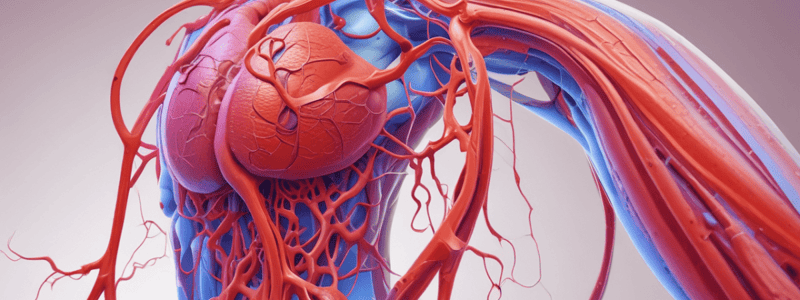Podcast
Questions and Answers
Intrinsic control mechanisms determine the distribution of blood to organs and the amount of blood directed to individual ______ beds.
Intrinsic control mechanisms determine the distribution of blood to organs and the amount of blood directed to individual ______ beds.
capillary
If a tissue's metabolic need is low, intrinsic mechanisms will ______ the flow to that tissue.
If a tissue's metabolic need is low, intrinsic mechanisms will ______ the flow to that tissue.
decrease
If the metabolic need is high, intrinsic mechanisms will ______ the flow to that tissue.
If the metabolic need is high, intrinsic mechanisms will ______ the flow to that tissue.
increase
The flow of blood to any particular organ is determined by the ______ gradient and the resistance to blood in that organ.
The flow of blood to any particular organ is determined by the ______ gradient and the resistance to blood in that organ.
Mean arterial pressure provides the same driving ______ to all organs in the systemic circuit that receive blood in parallel.
Mean arterial pressure provides the same driving ______ to all organs in the systemic circuit that receive blood in parallel.
Any difference in blood flow to organs must be due to differences in ______.
Any difference in blood flow to organs must be due to differences in ______.
Organs can increase or decrease the amount of blood they receive by ______ or increasing resistance.
Organs can increase or decrease the amount of blood they receive by ______ or increasing resistance.
Intrinsic control mechanisms ensure that all organs have an ______ supply of blood.
Intrinsic control mechanisms ensure that all organs have an ______ supply of blood.
Venoconstriction makes veins less ______, which increases pressure and facilitates venous return to the heart.
Venoconstriction makes veins less ______, which increases pressure and facilitates venous return to the heart.
Increased venous return to the heart results in increased ______ pressure, which increases end-diastolic pressure.
Increased venous return to the heart results in increased ______ pressure, which increases end-diastolic pressure.
Study Notes
Blood Flow Regulation
- When blood flow to one area of the body is decreased, it is redirected to other areas, commonly occurring between different organ systems.
- During exercise, blood flow increases to skeletal muscles, but is redirected from organs with low metabolic needs, such as the gut or kidneys.
Intrinsic Regulation of Blood Flow
- Intrinsic regulation occurs within organs to distribute blood according to metabolic needs.
- The brain is an example of intrinsic regulation, where blood flow is directed to specific areas depending on the activity being performed.
Types of Intrinsic Regulation
- There are four types of intrinsic regulation that act on blood vessels to change vessel diameter:
- Metabolic activity (active hyperemia): increased blood flow due to increased metabolic rate in tissues.
- Changes in blood flow (reactive hyperemia): increased blood flow in response to temporary blood flow reduction.
- Vasoconstriction: decreased blood flow due to increased vessel resistance.
- Vasodilation: increased blood flow due to decreased vessel resistance.
Mechanisms of Intrinsic Regulation
- Active hyperemia: increased oxygen consumption and carbon dioxide expulsion cause vasodilation, increasing blood flow and oxygen delivery.
- Reactive hyperemia: temporary blood flow reduction triggers vasodilation, increasing blood flow and oxygen delivery.
- Venoconstriction: increases pressure inside veins, pushing blood towards the heart, and increases venous return to the heart.
Intrinsic Regulation of Blood Flow to Organs
- Intrinsic control mechanisms determine the distribution of blood to organs and the amount of blood directed to individual capillary beds.
- Organs can increase or decrease blood flow by changing resistance.
- Organ blood flow is determined by the pressure gradient and resistance to blood in that organ.
Studying That Suits You
Use AI to generate personalized quizzes and flashcards to suit your learning preferences.
Related Documents
Description
Learn about how blood flow is redistributed in the body during exercise and which organs experience changes in perfusion levels. Understand the concept of cardiac output increase and the impact on different organ systems.




